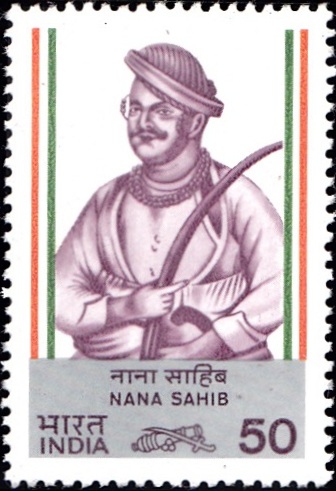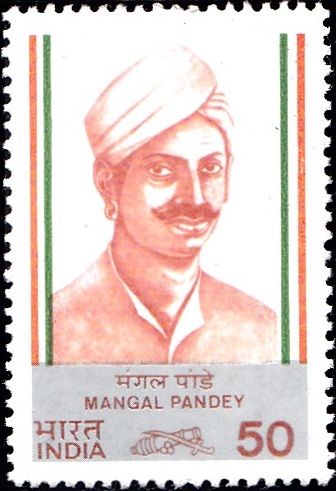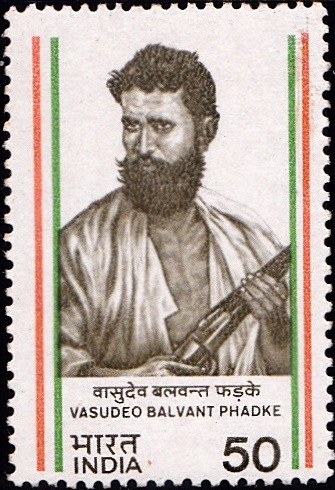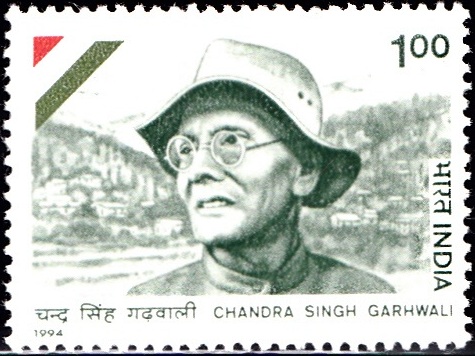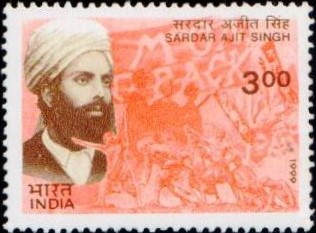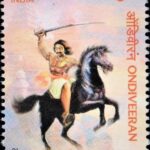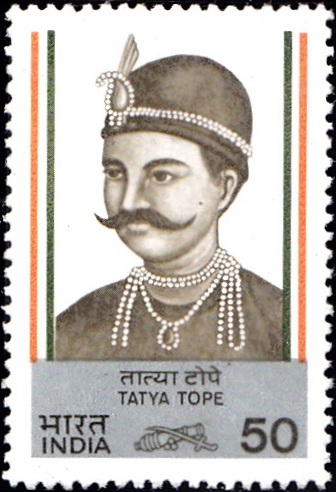
Tatya Tope
A commemorative postage stamp on Tantia Tope, a leader of Indian Rebellion of 1857 [a part of the series ‘India’s Struggle for Freedom‘] :
 Issued by India
Issued by India
Issued on May 10, 1984
Issued for : Indian Posts & Telegraphs Department is privileged to issue four commemorative stamps in the memory of these great Freedom Fighters.
Type : Stamp, Mint Condition
Colour : Single colour
Denomination : 50 Paise
Name : Ramchandra Panduranga
Born on 1814 at Yeola, Nashik district, Maharashtra, India
Died on Apr 18, 1859 at Shivpuri, British India [now in Madhya Pradesh]
About :
- The First War of Independence (1857-58) was the first general widespread uprising against the rule of the British East India Company. The Doctrine of Lapse, issue of cartridges greased with animal fat to Indian soldiers, introduction of British system of education and a number of social reforms had infuriated a very wide section of Indian people, who rose in revolt at a number of places all over India. The East India Company was brought under the direct rule of the British Crown as a result of this uprising.
- Of the very large number of freedom fighters, who led the struggle, four are being commemorated through the present series, which is a part of the larger series on India’s Struggle for Freedom.
- Tatya Tope also known as Ram Chandra Pandurang was born in 1814 at village Gola in Maharashtra. His father, Pandurang Rao Tope was an important noble at the court of the Peshwa Baji Rao–II. He shifted his family with the ill fated Peshwa to Bithur where his son became the most intimate friend of the Peshwa‘s adopted son, Nana Dhundu Pant, known as Nana Saheb.
- In 1851, when Lord Dalhousie deprived Nana Saheb of his father’s pension, Tatya Tope also became a sworn enemy of the British. In May 1857, when the political storm was gaining momentum, he won over the Indian troops of the East India Company, stationed at Kanpur, established Nana Saheb‘s authority and became the Commander-in-Chief of his revolutionary forces.
- After the reoccupation of Kanpur and separation from Nana Saheb, Tatya Tope shifted his headquarters to Kalpi to join hands with Rani Lakshmi Bai and led a revolt in Bundelkhand. He was routed at Betwa, Koonch, and Kalpi, but reached Gwalior and declared Nana Saheb as Peshwa with the support of the Gwalior contingent. Before he could consolidate his position he was defeated by General Rose in a memorable battle in which Rani Lakshmi Bai suffered martyrdom.
- After losing Gwalior to the British, he launched a successful guerrilla campaign in the Sagar and Narmada regions and in Khandesh and Rajasthan. The British forces failed to subdue him for over a year. He was, however, betrayed into the hands of the British by his trusted friend Man Singh, Chief of Narwar, while asleep in his camp in the Paron forest. He was captured and taken to Sipri where he was tried by a military court and executed at the gallows on April 18, 1859.
Subscribe
Login
0 Comments


